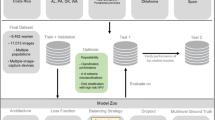Abstract
Cervical cancer is an important health concern and early detection is crucial for effective treatment. In this study, we propose a novel approach to computer-assisted cervical scans that uses a custom-based deep learning architecture, called Baby-Fortune Intelligent System (BFIS), designed for multiple binary classifications of the image of cervical cells. BFIS is trained on comprehensive publicly available data sets that include Pap smear captures. Comparative analysis with existing screening tools highlights the superior performance of the BFIS in terms of sensitivity, precision, and overall predictive accuracy. Our results underscore the potential of the proposed model as a valuable tool for cervical screening, which offers enhanced results and efficiency in identifying people at increased risk of cervical malignancies.
Access this chapter
Tax calculation will be finalised at checkout
Purchases are for personal use only
Similar content being viewed by others
References
Rerucha, C.M., Caro, R.J., Wheeler, V.L.: Cervical cancer screening. Am. Family Phys. 97(7), 441–448 (2018)
Sachan, P.L., Singh, M., Patel, M.L., Sachan, R.: A study on cervical cancer screening using pap smear test and clinical correlation. Asia-Pacific J. Oncol. Nurs. 5(3), 337–341 (2018). https://doi.org/10.4103/apjon.apjon_15_18
Patel, M.M., Pandya, A.N., Modi, J.: Cervical pap smear study and its utility in cancer screening, to specify the strategy for cervical cancer control. Nat. J. Community Med. 2(01), 49–51 (2011)
Basak, H., Kundu, R., Chakraborty, S., Das, N.: Cervical cytology classification using PCA and GWO enhanced deep features selection. SN Comput. Sci. 2(5), 369 (2021)
Secasan, C.C., et al.: Artificial intelligence system for predicting prostate cancer lesions from shear wave elastography measurements. Curr. Oncol. 29(6), 4212–4223 (2022)
Plissiti, M.E., Dimitrakopoulos, P., Sfikas, G., Nikou, C., Krikoni, O., Charchanti, A.: SipakMed: a new dataset for feature and image based classification of normal and pathological cervical cells in pap smear images. In: 2018 25th IEEE International Conference on Image Processing (ICIP), pp. 3144–3148. IEEE (2018)
Boers, J.E., Ambergen, A.W., Thunnissen, F.B.J.M.: Number and proliferation of basal and parabasal cells in normal human airway epithelium. Am. J. Respir. Crit. Care Med. 157(6), 2000–2006 (1998). https://doi.org/10.1164/ajrccm.157.6.9707011
Cohenford, M.: Cytologically normal cells from neoplastic cervical samples display extensive structural abnormalities on IR spectroscopy: implications for tumor biology. Proc. Natl. Acad. Sci. 95(26), 15327–15332 (1998)
Sipakmed WSI data, pap smear data set. Accessed 27 Feb 2024. https://www.kaggle.com/datasets/bornarado/papsmeardatasets
Breiman, L.: Random forests. Mach. Learn. 45, 5–32 (2001)
Sun, G., Li, S., Cao, Y., Lang, F.: Cervical cancer diagnosis based on random forest. Int. J. Perform. Eng. 13(4), 446 (2017)
Kumar, R., Srivastava, R., Srivastava, S.: Detection and classification of cancer from microscopic biopsy images using clinically significant and biologically interpretable features. J. Med. Eng. (2015)
Szegedy, C., et al.: Going deeper with convolutions. In: Proceedings of the IEEE Conference on Computer Vision and Pattern Recognition, pp. 1–9 (2015)
Zhong, Z., Jin, L., Xie, Z.: High performance offline handwritten Chinese character recognition using GoogLeNet and directional feature maps. In: 2015 13th International Conference on Document Analysis and Recognition (ICDAR), pp. 846–850. IEEE (2015)
Zainal Ariffin, S.M.Z.S., Ali Musa, H.H., Jamil, N.: Performance comparison of convolutional neural network models on cervical cell classification. In: 2021 IEEE International Conference on Artificial Intelligence in Engineering and Technology (IICAIET), pp. 1–5. IEEE (2021)
Lin, H., Yuyang, H., Chen, S., Yao, J., Zhang, L.: Fine-grained classification of cervical cells using morphological and appearance based convolutional neural networks. IEEE Access 7, 71541–71549 (2019)
Zeiler, M.D., Fergus, R.: Differentiable pooling for hierarchical feature learning. arXiv preprint arXiv:1207.0151 (2012)
Shanthi, K., Manimekalai, S.: An efficient cervical image segmentation method using Lagrange dual dictionary learning in convolutional neural network. Ann. Rom. Soc. Cell Biol., 1944–1957 (2021)
Al-Yafeai, Z.M.A.: Cervical cancer classification using deep learning techniques. PhD thesis, King Fahd University of Petroleum and Minerals (Saudi Arabia) (2018)
Nair, V., Hinton, G.E.: Rectified linear units improve restricted boltzmann machines. In: Proceedings of the 27th International Conference on Machine Learning (ICML-10), pp. 807–814 (2010)
Fluss, R., Faraggi, D., Reiser, B.: Estimation of the Youden index and its associated cutoff point. Biometrical J.: J. Math. Methods Biosciences 47(4), 458–472 (2005)
Acknowledgement
The authors thank the Doctoral Mathematics and Informatics School of the West University of Timişoara for the funds. The authors also thank Darian Onchiş, Florin Fortiş, and Todor Ivaşcu for their support and suggestions.
Author information
Authors and Affiliations
Corresponding author
Editor information
Editors and Affiliations
Rights and permissions
Copyright information
© 2024 The Author(s), under exclusive license to Springer Nature Switzerland AG
About this paper
Cite this paper
Babuc, D., Fortiş, AE. (2024). A Customizable Intelligent System for Cervical Cytology Image Classifications. In: Barolli, L. (eds) Complex, Intelligent and Software Intensive Systems. CISIS 2024. Lecture Notes on Data Engineering and Communications Technologies, vol 87. Springer, Cham. https://doi.org/10.1007/978-3-031-70011-8_8
Download citation
DOI: https://doi.org/10.1007/978-3-031-70011-8_8
Published:
Publisher Name: Springer, Cham
Print ISBN: 978-3-031-70010-1
Online ISBN: 978-3-031-70011-8
eBook Packages: Intelligent Technologies and RoboticsIntelligent Technologies and Robotics (R0)




